CLAY MINERALS OF LATE CRETACEOUS SONG-LIAO BASIN AND THEIR SEDIMENTARY ENVIRONMENT
- Received Date: 1983-08-08
- Publish Date: 1985-12-10
Abstract: Clay minerals in ancient deposits are regarded as sensitive indicators for the changes in sendimentary environment, which makes it possible to trace back to the origin of materials, paleoclimatic conditions and environmental characteristics of sedimentary basins. The samples studied in this paper were detrmined by means of X-ray diffraction, differential thermal analysis,infrared absorbed spectral analysis, electron microscope and chemical analysis. These analyses show that the clay fractions in Late Cretaceous consist of smectite, illite, chlorite with a minor amount of quartz, feldspar, analcite and carbonate among which the illite is the most abundant and common clay mineral in the basin, and it is mostly detrital in origin, with some characters inherited form the mother rock according to TEM studies. The Qing Shankou and Nenjiang Formations contain hexagonal authigenic illite, which was formed by the fixation of potassium and the expulsion of inter-layer water on smectite layers through diagenetic alternation, reflecting a condition of alkaline water medium rich in K+. The smectite appears abundant throughout the formations except the Qing Shankou Formation which chiefly originated form volcanic source rocks and was formed under an alkaline medium condition with a hot and arid climate. The chlorite includes detrital and authigenic forms. The content of the former might indicate the distance of the sediments from the erosion areas, while that of the authigenic can be interpreted as a result of halmyrolytic alternation, reflecting effects of the sea water. The analcite is also related to volcanic materials which were transformed into analcites under a condition of water medium with increasing salinity and alkalinity through diagenetic alternation.Therefore,the presence of analcite indicates an environment marked by the increasing salinity and alkalinity. The terrigenous feldspar is one of the important non-clay minerals in the basin, and its well-preserved tabular crystals indicating an arid paleoclimatic condition. The"suitable B content" of the clay minerals relates directly to paleosalinity, possibly indicating the salinity of water medium. The clay assemblages and stratigraphic variations can be summarized as follows: The Quantou Formation is composed of illite, chlorite, smectite and non-clay minerals such as feldspar and quartz. The"suitable B content"is 140 ppm, reflecting a condition of fresh water and alkaline water medium with hot to arid climates and representing sediments close to erosion areas. In the Qing Shankou Formation, the clay fractions are rich in illite with small quantity of authigenic chlorite, illite and analcite, but no smectite and feldspar, the"suitable B content"is 240 ppm.These sedimentary components had ever been subjected to transgression, indicating a brackish and alkaline water medium. The Yaojia Formation contains illite and smectite with rich feldspar, but no chlorite, the"suitable B content"is 100 ppm, suggesting drier climate than before and a fresh water medium condition. Nenjiang Formation is characterized by the abundant smectite associated with illite, chlorite and feldspar. The "suitable B content" is 285 ppm, reflecting a brackish water medium. The well-crystallized smectite in Members D1 and D3 indicates a stable and deepened water body. The feldspar decreases from Member D3 upwards, and the siderite appears. The basin was uplifted under a moist climate. Based on the preliminary study, the author is inclined to suggest that the Late Cretaceous Song-Liao basin should be a hemipelagic one rather than an inland lake as traditionally recognized, and that its strata were mainly formed under the enviro-ment with an arid paloeoclimate and a freshbrackish alkaline water medium.Both the Qing Shankou and Nenjiang Formations had been subjected to transgression. These results are somewhat useful in the genetic research on oil-bearing strata.
| Citation: | Liu Yun. CLAY MINERALS OF LATE CRETACEOUS SONG-LIAO BASIN AND THEIR SEDIMENTARY ENVIRONMENT[J]. Acta Sedimentologica Sinica, 1985, 3(4): 131-140. |






 DownLoad:
DownLoad: